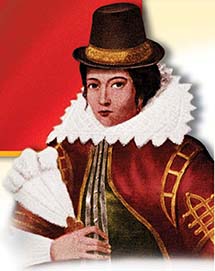SECTION 3: England’s Southern Colonies

▲ Pocahontas in European clothing
WITNESS HISTORY  AUDIO
AUDIO
Pocahontas
The earliest English settlers at Jamestown would have perished without assistance from Native Americans. A young Indian girl named Pocahontas was especially helpful. A daughter of Chief Powhatan, Pocahontas visited the Jamestown settlement and carried messages between the settlers and her father.
Despite Pocahontas’s help, conflict arose between the Native Americans and the Jamestown colonists. During a period of warfare, Pocahontas was held captive in Jamestown. During this captivity, she and settler John Rolfe became engaged and later married. Both the Indians and the English settlers viewed the marriage between Rolfe and Pocahontas as a chance to end the war.
Objectives
- Describe how Jamestown was settled, why the colony struggled, and how it survived.
- Explain the relationship of Indians and settlers in the Southern Colonies.
- Discuss the settlement of Maryland, the Carolinas, and Georgia.
Terms and People
- charter
- joint-stock company
- Powhatan
- John Smith
- House of Burgesses
- royal colony
- proprietary colony
- Bacon’s Rebellion
- Lord Baltimore
- James Oglethorpe
NoteTaking
Reading Skill: Sequence As you read this section, use a flowchart to list the important events in the founding of the Southern Colonies. Add boxes as you need them.

Why It Matters Neglected by the Spanish and French, the Atlantic coast remained open to English colonization during the 1580s. England’s first attempts to establish a colony in North America failed, but in 1607 they succeeded in founding Jamestown, which became part of the colony of Virginia. By 1732, four more Southern Colonies had been established: Maryland, North Carolina, South Carolina, and Georgia. Section Focus Question: What were the characteristics of the government and the economy in the Southern Colonies?
England’s First American Colonies
The first promoters of English colonies were wealthy gentlemen from southwestern England. They included Sir Walter Raleigh, a special favorite of Queen Elizabeth I. English patriots and devout Protestants, these men wanted to advance their fortunes and increase the power of England.
They promised that an American colony would solve England’s problems: a growing population and increased poverty due to a stagnant economy. The promoters proposed shipping poor people across the Atlantic to work in a new colony. By mining for gold and silver and by raising plantation crops, these workers would generate new wealth for England.
Roanoke Colony Fails
After obtaining a charter, or certificate of permission, from the king, the group formed a joint-stock company. This was a business venture founded and run by a group of investors




